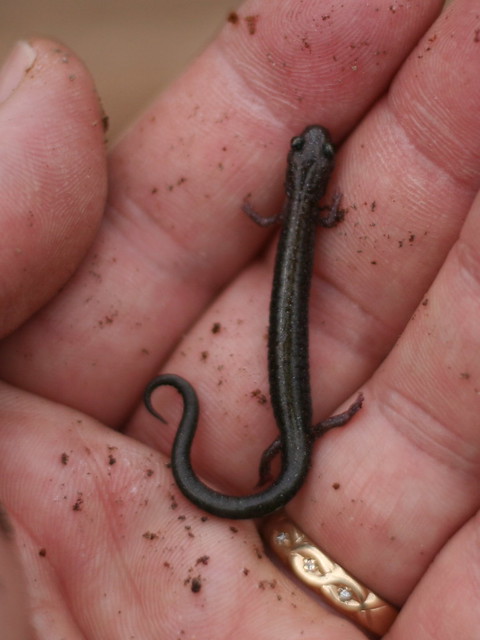
Estimates of the total number of species on earth range from five to thirty million, of which only approximately two million have been formally described (see How Many Species are There?). Incredible! But I'd like to bring the discussion down a little closer to home-- something I can wrap my head around.
Yes, I'm stuck on salamanders. My home state of Illinois has twenty species of salamanders. I've been out looking for them and reading up on them a bit recently1 and there's some amazing variety just among the salamanders of Illinois. For example, the salamander pictured above is a redback salamander, but you don't have to be a very astute observer to note that it doesn't have a red back. That's because up to 35% of redback salamanders (and up to 97% in one Illinois county!) lack their red stripe (here's one with the stripe).
But the fun is just beginning. We all know that salamanders are amphibians, like frogs and toads, and that their eggs are laid in water, hatch into tadpole-like "larvae" and later metamorphose into adults, right? Well, yes and no. Redback salamanders along with a few others (the northern slimy salamander is another Illinois salamander with this characteristic) are completely terrestrial. Their eggs are laid on land and their young completely bypass the aquatic tadpole stage. On the other end of the spectrum, hellbenders, mudpuppies and lesser sirens are three Illinois species that are completely aquatic, spending their entire lives in the water breathing through gills. Then just to be different, the eastern newt has a three-part life cycle starting life in the water as most salamanders do, entering a terrestrial lifestyle for a couple of years, and then returning to the water to live out their adult lives.
In my previous post I described an enchanting visit to a temporary woodland pool full of spotted salamanders. Several Illinois species take advantage of these temporary pools for early spring breeding-- the major advantage being that temporary pools have no fish to eat eggs or larvae. However, one Illinois species has a completely different approach. The marbled salamander comes to dry pools in the fall to lay their eggs. The eggs are strategically positioned far enough up the side of the dry pool so that if the water reaches them and causes them to hatch, there is sufficient water there to last until the larvae metamorphose into adults. They actually grow and mature throughout the winter months.
Finally, for something completely different, there is in Illinois, albeit at only one location, a salamander species that is all female. The silvery salamander is one of several salamander species that are essentially all female clones of one another...
O LORD, what a variety of things you have made!
In wisdom you have made them all.
The earth is full of your creatures.
Psalm 104:24
1My main source for reading about the reptiles and amphibians of Illinois, and the source of most of the facts in this post is the Field Guide to Amphibians and Reptiles of Illinois. I have also been enjoying very much Swampwalker's Journal: A Wetlands Year and highly recommend it. This is where my information about the marbled salamander comes from.
